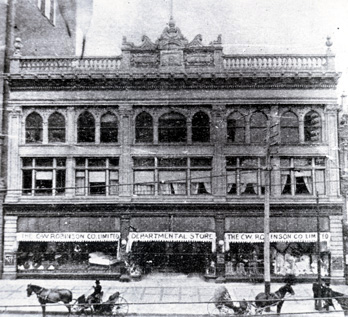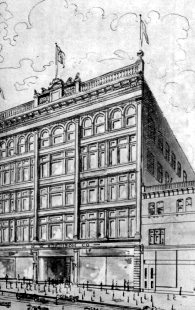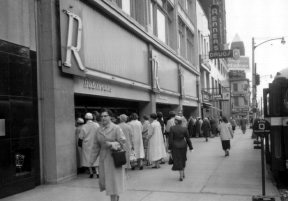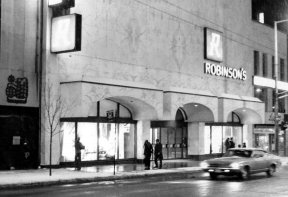Just one year later, the F.W. Watkins Company Limited went
bankrupt. His creditors foreclosed on the mortgage and sold the building to George Webster
Robinson. On November 6, 1899, G.W. Robinson opened a retail department store that would
carry his name. In time, this retail store would become one of the biggest businesses in
the City of Hamilton, and would make James Street South one the busiest retail districts
in the area. Many believed that the store owed much of its success to its convenient
downtown location, being close to buses, railways, and streetcars, and also to the fact
that it was Hamilton born, owned, and operated.
Robinson saw the need for something unusual to draw the public to his store, which at
the time, lay outside the retail nucleus of King Street East. He therefore arranged to
have the first showing of a motion picture in Canada in his store. The shows were held in
a roped off section on the second floor which was made dark for the occasion. His idea was
an instant success, proving to be excellent for business, and for the reputation of the
store. Profits increased continually, as did the size of the business. The thriving store
outgrew its premises and required several renovations enlarging the facilities to
accommodate the expansion.
The building, which housed the store in 1899, stood two-storeys high. Just twenty years
after opening, the store stood over five-storeys high. In 1920, another storey was added
onto the building, and a rear addition added an extra floor space of 18,000 square feet.
The renovation project also included the installation of a 2-way escalator, travelling
from the first floor to the second floor. The escalator ran on electricity and was capable
of moving at a speed of 70 feet per minute or 2,100 people per hour. It was built and
installed by Otis-Fenson Elevator Company. All departments were equipped with electric
cash registers to increase the efficiency of customer service, and a new soda fountain and
luncheonette were added. The interior was finished in a rich mahogany and steam tables
were installed to ensure that food was served hot. There were buffet seats and glass
topped tables for the comfort of the patrons. The fifth floor was entirely a new addition,
whose use predominantly served as a storeroom and workroom, while also providing space for
further expansion if ever necessary.
By 1924, Robinson’s had been given the reputation of being known as
"Hamilton’s Shopping Centre", and had grown into one of the mightiest
department stores in Canada. For the Robinson Company, the customer was the backbone of
their success. This was illustrated by their slogan, "Quality and Service", a
term which was born out of the idea that the employees of Robinson’s owed their
employment to the customer who made the store their shopping place. Robinson’s staff
was encouraged to ensure that each customer was served quietly, efficiently and quickly.
To encourage their staff, Robinson’s, among few retail stores, shared its annual
profits with its employees.
 The Robinson’s store was ravaged by a
disastrous fire in March of 1926. The total damage was estimated at $700,000. The upper
floors were gutted by fire while the lower floors, where stock was stored, were severely
damaged by water. It was suspected that the fire began somewhere between the roof and the
ceiling of the fifth floor. Firefighters, upon arriving on the scene, met with a solid
wall of fire that stretched 200 feet from the front to the rear of the building.
The Robinson’s store was ravaged by a
disastrous fire in March of 1926. The total damage was estimated at $700,000. The upper
floors were gutted by fire while the lower floors, where stock was stored, were severely
damaged by water. It was suspected that the fire began somewhere between the roof and the
ceiling of the fifth floor. Firefighters, upon arriving on the scene, met with a solid
wall of fire that stretched 200 feet from the front to the rear of the building.
When all was said and done, the storefront display windows looked like aquariums, James
Street was a frozen mass, and the Robinson’s store was destroyed.
In 1929, G.W. Robinson retired and appointed R.L. Smith, former Vice-President, as
President of the Company. Smith had been connected with the retail business for over 25
years, having been the General Manager of R. McKay & Co., dry goods, located on King
Street East.
In 1954, the Company was sold to the British firm of Owen & Owen Limited of
Liverpool, who owned and operated ten English department stores. The company had been
associated with Robinson’s for years, as a British agent and purchaser. The Owen
& Owen Company planned a renovation for the James Street store. They decided to
construct a new storefront and install new high-speed elevators and escalators. The
contract, worth an estimated $200,000, was given to Otis Elevator Company. The architect
for the modernization project was Peter Bell of William Souter & Associates. The new
storefront was designed to harmonize as much as possible with exterior of the Royal Bank.
An article in The Spectator, dated September 27, 1957 described the fašade: "The
striking storefront will feature an innovation in Canadian merchandizing – the first
use of a new type of non-reflecting window in this country. This eye-catching design
concept employs broad expanses of glass sloping rearward from a knee-high handrail. Window
reflections are absorbed by the dark underside of a projecting canopy and fluorescent
lighting is concealed in the handrail to supplement illuminations from overhead. This
combination softens shadows and provides backlighting for an attention-winning
display." The modernization project gave Robinson’s the largest display
windows in the city. The entire main floor was to be a background for window shoppers
passing in the street.
 Over the next six years, the James Street store
underwent extensive renovations whose total cost came to $1,300,000. In 1959, at a cost of
$100,000, a new air conditioning system was installed. The project was carried out by
Goodram Brothers Limited of Hamilton. A newly painted mural decorated the main floor. It
was a montage depicting the new City Hall, the Skyway Bridge and busy construction
equipment. All this was presided over by the familiar Gore Park statue of Queen Victoria.
The main floor was finished in beige banded in blue, with diffused lighting. The second
phase of the renovation, costing $185,000 included the installation of a new stairway to
the second floor, the replacement of the escalator, a new ceiling and floor, and an
advanced type of design for each of the merchandise displays.
Over the next six years, the James Street store
underwent extensive renovations whose total cost came to $1,300,000. In 1959, at a cost of
$100,000, a new air conditioning system was installed. The project was carried out by
Goodram Brothers Limited of Hamilton. A newly painted mural decorated the main floor. It
was a montage depicting the new City Hall, the Skyway Bridge and busy construction
equipment. All this was presided over by the familiar Gore Park statue of Queen Victoria.
The main floor was finished in beige banded in blue, with diffused lighting. The second
phase of the renovation, costing $185,000 included the installation of a new stairway to
the second floor, the replacement of the escalator, a new ceiling and floor, and an
advanced type of design for each of the merchandise displays.
On July 10, 1961, the two historic merchandising names of G.W. Robinson and Finch
Brothers Limited, located on King Street West, merged. In an agreement between the two,
the Finch store was sold to the Robinson’s company, thereby giving Robinson’s
access to the three main business arteries of James, King and MacNab Streets.
Robinson’s then opened a budget store, spending $65.000 on renovations, which
included the installation of new fixtures, lighting, air-conditioning and stairs. The two
floors were converted into a self-serve, high quality, low cost retail merchandising
operation. According to Mr. Dakin, general manager of Robinson’s, the purpose of the
new store was to speed up shopping for those who preferred the self-service method and
wished to carry their purchases with them. The store was to provide a wide variety of
clothing and accessories.
The following years, the last traces of the nineteenth century architectural design
were removed. Craftsmen were employed to replace the brick and multi-windowed front with
marble panels and stainless steel grill. In addition, the company planned to construct
Hamilton’s first overhead pedestrian link between the two downtown stores. The
project was designed by Prack and Prack and erected by Pigott
Construction Company.
On October 15, 1968, Robinson’s opened a store in Burlington, located at
Burlington Mall. The interior, occupying 100,000 square feet, was designed by Copeland,
Novak and Iarari. The aisles were wide and the ceilings were high. Diffused lighting was
used throughout, and the floors were finished in either gleaming tiles or soft carpeting.
There was a beauty salon, a hearing aid department, a garden shop, and a restaurant, whose
name, Fisher’s Court Restaurant, marked the link between the mall and the pioneer
Nelson Township family, on whose farm the mall is located.
In 1969, plans went ahead to make the James Street store as modern in appearance as the
Burlington store. The company allotted $2,000,000 for the project. The rebuilding program
was to include a new front fascia and a new canopy. The show windows were brought out to
the street, and the exterior sides and the back of the store were finished in a
combination of white marble and bronze tone aluminum, to compliment the previously
installed Italian marble, on the front of the store. The second phase of this renovation
project was to include an addition to the rear of the store.
A new store was constructed at Eastgate Mall in 1972. The
following year another store was built in Kitchener at the Fairview Park Shopping Centre.
The company opened new stores at an estimated rate of one per year. In October of 1975, it
was announced that a store would open in the Penn Centre in St. Catharines, while another
store, in Niagara Falls was scheduled to open in 1977.
In the early 1980s, the nine Robinson’s stores were purchased by two Vancouver
businessmen, Joseph Segal and John Levy. Both new owners were familiar with retail
operations. Mr. Segal was the previous owner of Fields Department Store in British
Columbia. In 1976 he acquired controlling interest in the 156-store Zellers chain. Mr.
Levy was first associated with Mr. Segal in the Fields operation and eventually retired as
President and CEO of Zellers. He returned from retirement when the purchase was made. Levy
and Segal decided that the store would continue operating under the Robinson name. Two
years after the company was taken over by Segal and Levy, they joined forces with the
three-store chain in Ottawa of Charles Ogilvy Limited.
Next to come was the debate over Sunday shopping. In December 1983, the Robinson-Ogilvy
stores decided to open on Sundays for a seven-hour shopping day, which was a huge success.
The number of shoppers in attendance was immense and the profits soared. This would mark
the beginning of a long controversial debate over whether stores should be allowed to open
on Sunday. The Robinson stores were continually fined by the Police department for opening
on Sundays, which opposed the shopping laws.
Plans to move the headquarters from Hamilton to Burlington were carried out in 1984.
The company had rented 30,000 square feet of office space on Blair Road. The following
year, Robinson’s abandoned their traditional market and became a "seven-day-a-week discount
operation", selling goods at prices between ten and fifty cents below other major
stores. The change was fueled by the store’s difficulty in competing with larger
chains, such as Eaton’s and Sears. The store was seeking to break new ground in
Canada by offering brand name goods at prices below those of other chains..
"seven-day-a-week discount
operation", selling goods at prices between ten and fifty cents below other major
stores. The change was fueled by the store’s difficulty in competing with larger
chains, such as Eaton’s and Sears. The store was seeking to break new ground in
Canada by offering brand name goods at prices below those of other chains..
In January of 1974, the Company had decided it was necessary to have a warehouse in
which to store their merchandise. The warehouse was located in Stoney Creek and cost
$1,500,000 to construct. Twelve years later it was torn down, and the one hundred
employees that staffed the warehouse were laid off. The reason for the closure was
financial; the company could not afford shipping stock to a central warehouse. Instead, it
was decided that the goods would be shipped directly to the stores. The employees were
given a severance package of one-week severance pay for every year of service. This
agreement exceeded the requirements of the Employee Standard Act.
By 1986, Comark Services Inc., which already owned 650 retail stores in
Canada, announced its expressed intention to purchase all the outstanding common shares of
the twelve Robinson Ogilvy Ltd. stores. It was hoped that the take over would bring some
stability to the suffering retail giant. The Comark Company decided to have
Robinson’s continue to operate as a traditional department store. Their pricing was
to fall somewhere between the levels of Sears and Eaton’s.
In 1989, the original Robinson’s store, located on James Street South, was slated
for closure. The company ensured the store staff that their positions were secure; they
would simply be transferred to another location. The closure was prompted by prolonged
operation difficulties related to reduced pedestrian traffic on James South after the
construction of Jackson Square. The Royal Bank then purchased the Robinson building which
was conveniently located beside its James Street Branch.
In 1992, five more Robinson’s stores, including two in Hamilton, were sold to the
Hudson’s Bay Company. The stores included the Robinson’s outlets at Eastgate
Square, Centre Mall, Lime Ridge Mall, the Penn Centre in St. Catharines, and Place
d’Orleans in Ottawa. There were also plans to sell other stores in Ottawa, Kitchener,
and Waterloo. According to Robinson’s President Gord Fauteaux, the sale of the stores
was part of ongoing efforts to downsize.
Eventually, all the stores belonging to the G.W. Robinson chain were closed and
disappeared from the retail scene. The James Street store in recent years, was torn down
and a parking lot now lies in its place.

 Just one year later, the F.W. Watkins Company Limited went
bankrupt. His creditors foreclosed on the mortgage and sold the building to George Webster
Robinson. On November 6, 1899, G.W. Robinson opened a retail department store that would
carry his name. In time, this retail store would become one of the biggest businesses in
the City of Hamilton, and would make James Street South one the busiest retail districts
in the area. Many believed that the store owed much of its success to its convenient
downtown location, being close to buses, railways, and streetcars, and also to the fact
that it was Hamilton born, owned, and operated.
Just one year later, the F.W. Watkins Company Limited went
bankrupt. His creditors foreclosed on the mortgage and sold the building to George Webster
Robinson. On November 6, 1899, G.W. Robinson opened a retail department store that would
carry his name. In time, this retail store would become one of the biggest businesses in
the City of Hamilton, and would make James Street South one the busiest retail districts
in the area. Many believed that the store owed much of its success to its convenient
downtown location, being close to buses, railways, and streetcars, and also to the fact
that it was Hamilton born, owned, and operated.
 The Robinson’s store was ravaged by a
disastrous fire in March of 1926. The total damage was estimated at $700,000. The upper
floors were gutted by fire while the lower floors, where stock was stored, were severely
damaged by water. It was suspected that the fire began somewhere between the roof and the
ceiling of the fifth floor. Firefighters, upon arriving on the scene, met with a solid
wall of fire that stretched 200 feet from the front to the rear of the building.
The Robinson’s store was ravaged by a
disastrous fire in March of 1926. The total damage was estimated at $700,000. The upper
floors were gutted by fire while the lower floors, where stock was stored, were severely
damaged by water. It was suspected that the fire began somewhere between the roof and the
ceiling of the fifth floor. Firefighters, upon arriving on the scene, met with a solid
wall of fire that stretched 200 feet from the front to the rear of the building.  Over the next six years, the James Street store
underwent extensive renovations whose total cost came to $1,300,000. In 1959, at a cost of
$100,000, a new air conditioning system was installed. The project was carried out by
Goodram Brothers Limited of Hamilton. A newly painted mural decorated the main floor. It
was a montage depicting the new City Hall, the Skyway Bridge and busy construction
equipment. All this was presided over by the familiar Gore Park statue of Queen Victoria.
The main floor was finished in beige banded in blue, with diffused lighting. The second
phase of the renovation, costing $185,000 included the installation of a new stairway to
the second floor, the replacement of the escalator, a new ceiling and floor, and an
advanced type of design for each of the merchandise displays.
Over the next six years, the James Street store
underwent extensive renovations whose total cost came to $1,300,000. In 1959, at a cost of
$100,000, a new air conditioning system was installed. The project was carried out by
Goodram Brothers Limited of Hamilton. A newly painted mural decorated the main floor. It
was a montage depicting the new City Hall, the Skyway Bridge and busy construction
equipment. All this was presided over by the familiar Gore Park statue of Queen Victoria.
The main floor was finished in beige banded in blue, with diffused lighting. The second
phase of the renovation, costing $185,000 included the installation of a new stairway to
the second floor, the replacement of the escalator, a new ceiling and floor, and an
advanced type of design for each of the merchandise displays.  A new store was constructed at Eastgate Mall in 1972. The
following year another store was built in Kitchener at the Fairview Park Shopping Centre.
The company opened new stores at an estimated rate of one per year. In October of 1975, it
was announced that a store would open in the Penn Centre in St. Catharines, while another
store, in Niagara Falls was scheduled to open in 1977.
A new store was constructed at Eastgate Mall in 1972. The
following year another store was built in Kitchener at the Fairview Park Shopping Centre.
The company opened new stores at an estimated rate of one per year. In October of 1975, it
was announced that a store would open in the Penn Centre in St. Catharines, while another
store, in Niagara Falls was scheduled to open in 1977.
 "seven-day-a-week discount
operation", selling goods at prices between ten and fifty cents below other major
stores. The change was fueled by the store’s difficulty in competing with larger
chains, such as Eaton’s and Sears. The store was seeking to break new ground in
Canada by offering brand name goods at prices below those of other chains..
"seven-day-a-week discount
operation", selling goods at prices between ten and fifty cents below other major
stores. The change was fueled by the store’s difficulty in competing with larger
chains, such as Eaton’s and Sears. The store was seeking to break new ground in
Canada by offering brand name goods at prices below those of other chains.. 